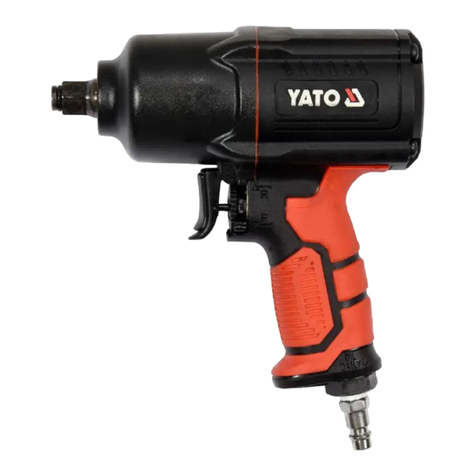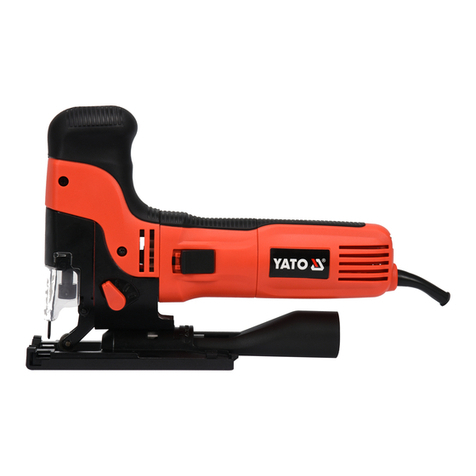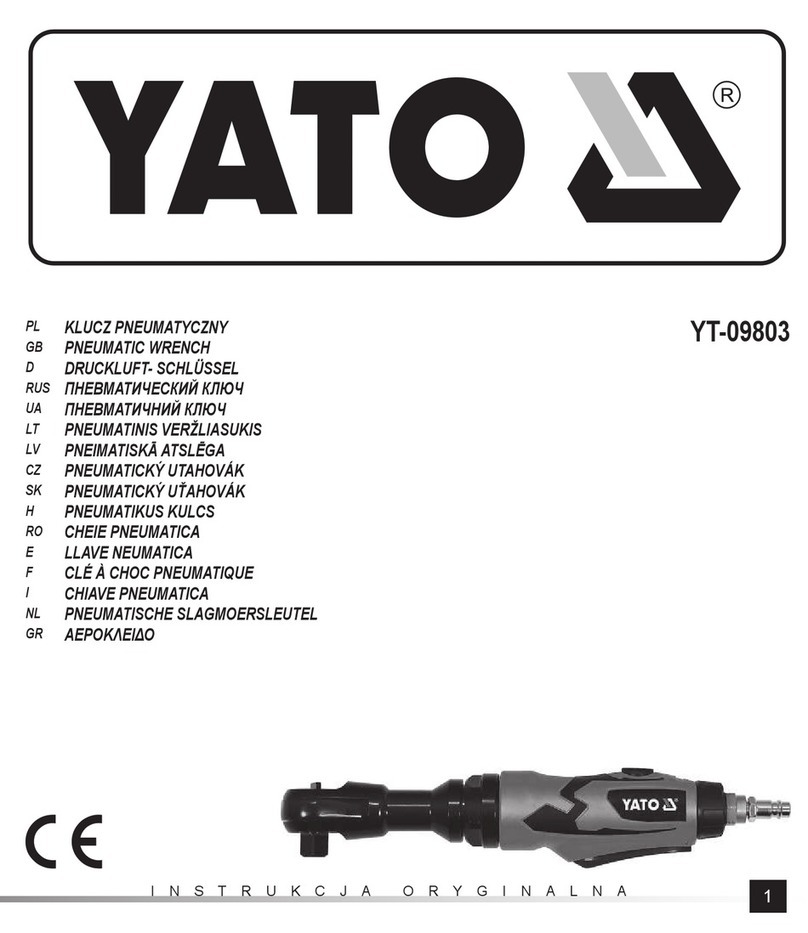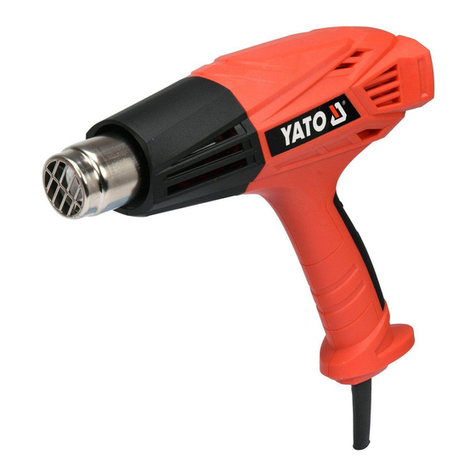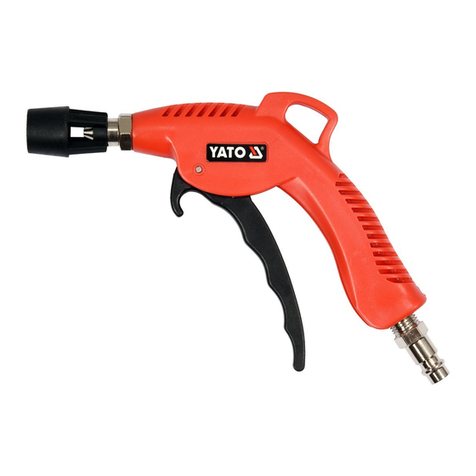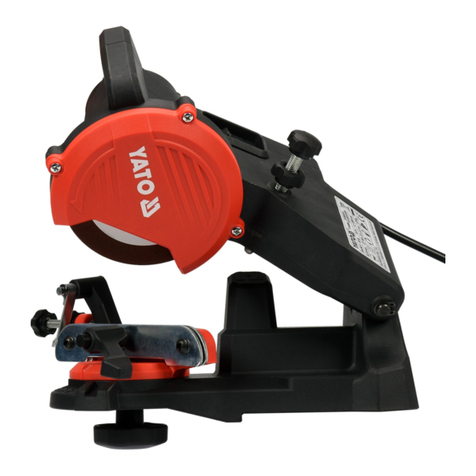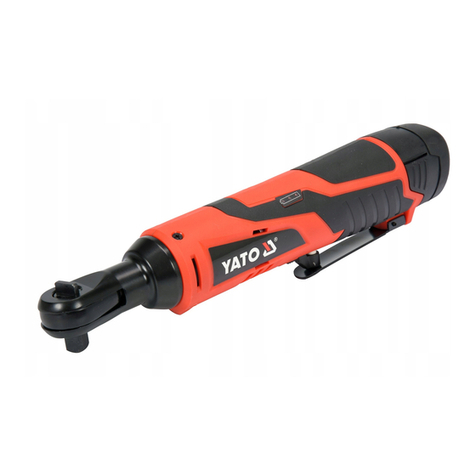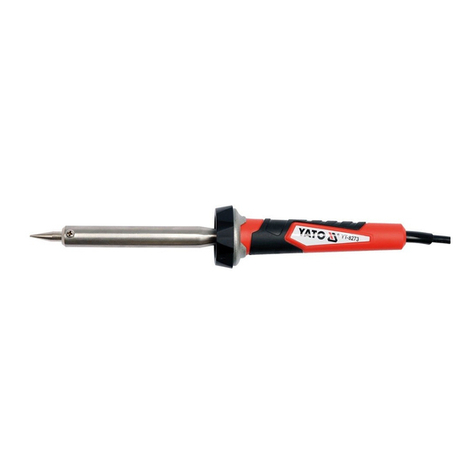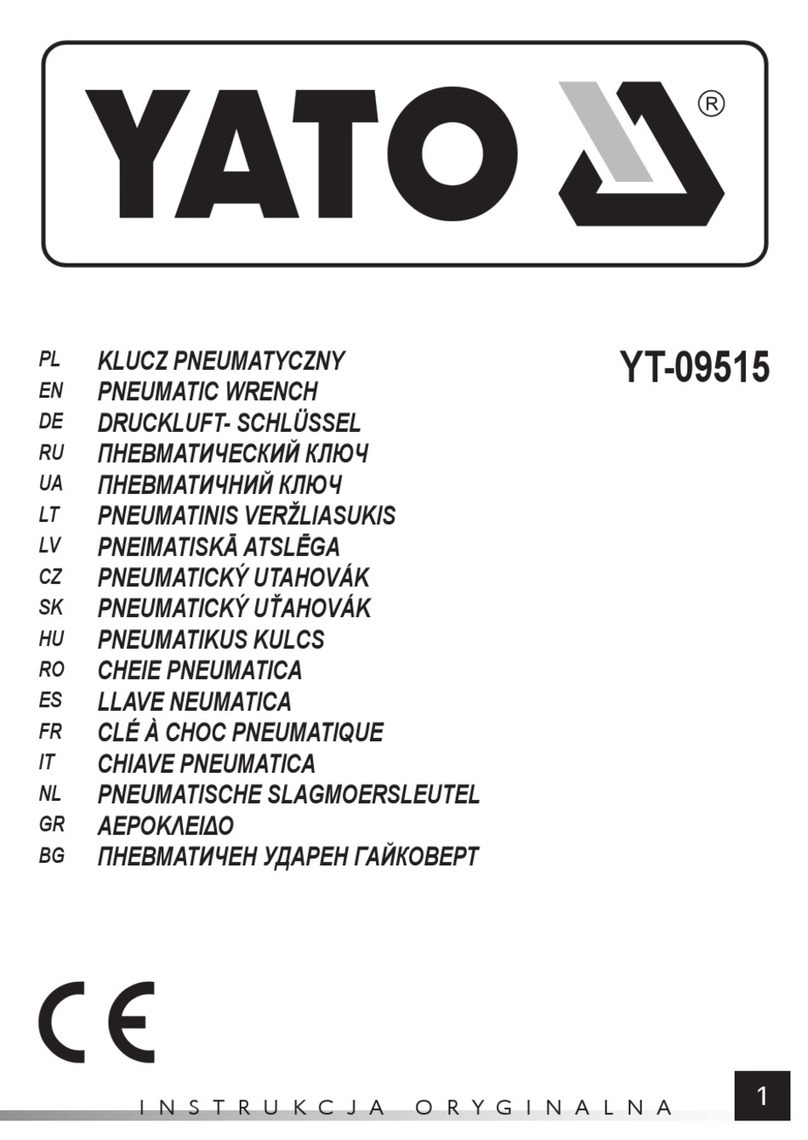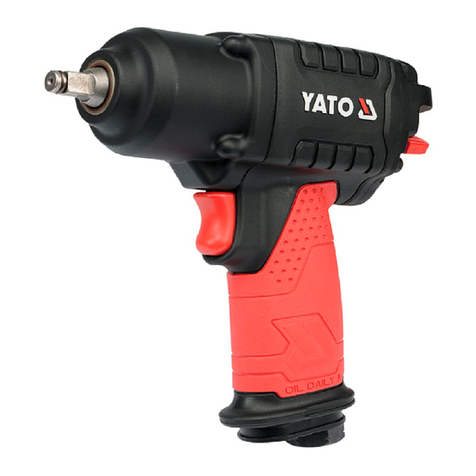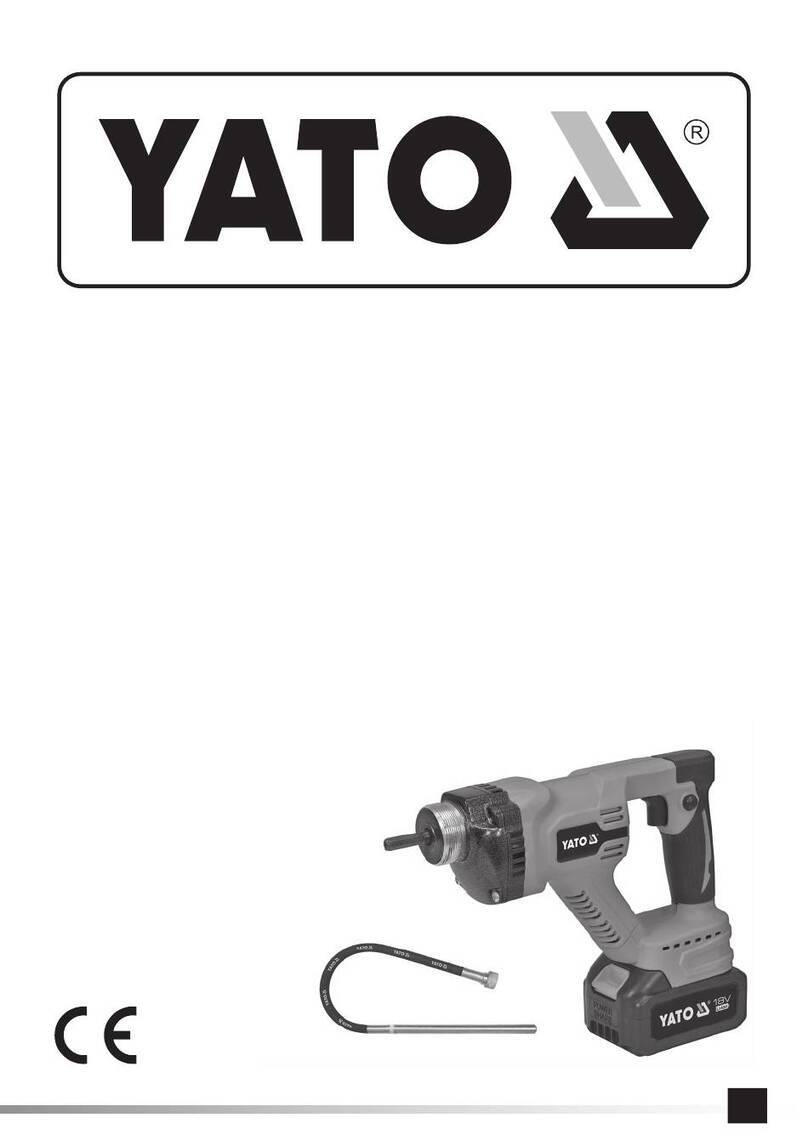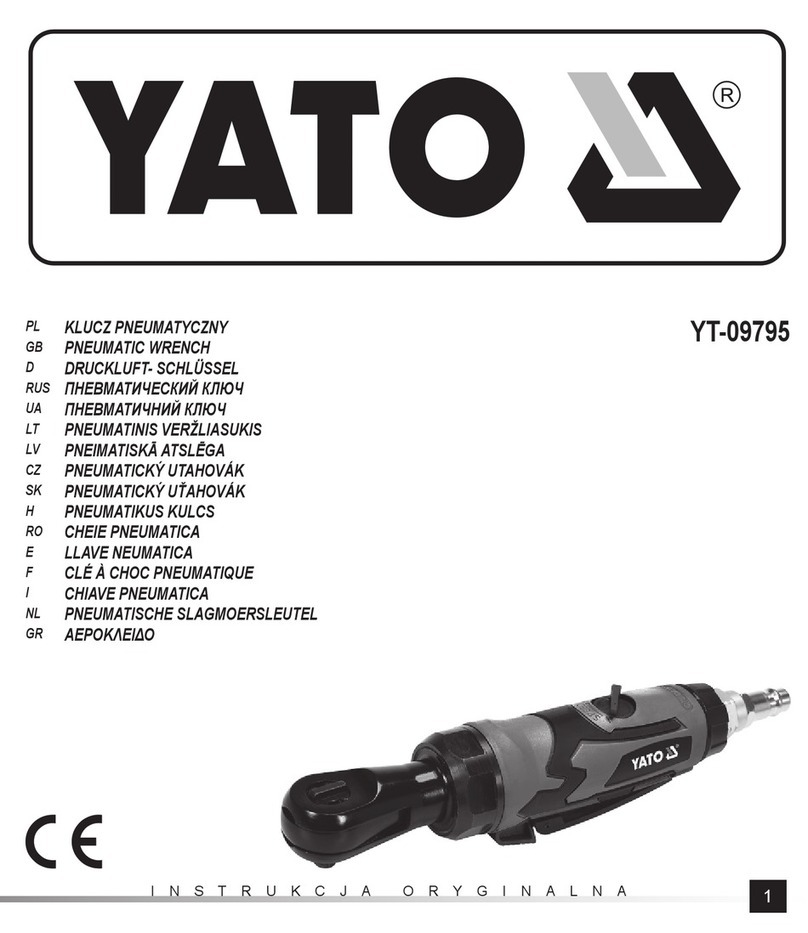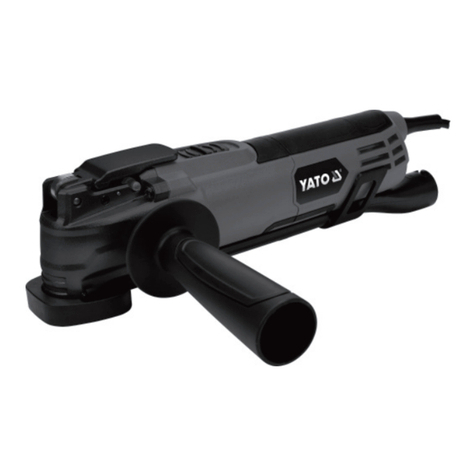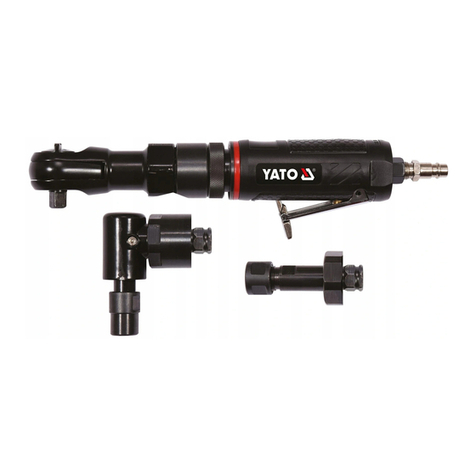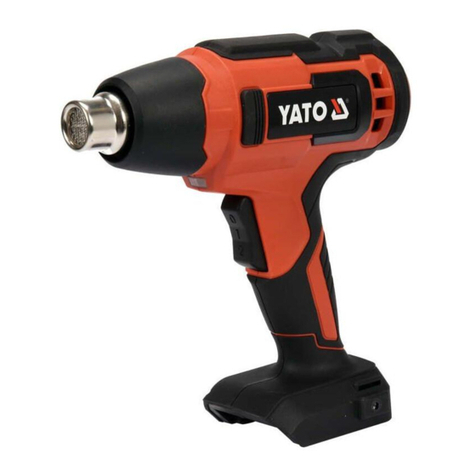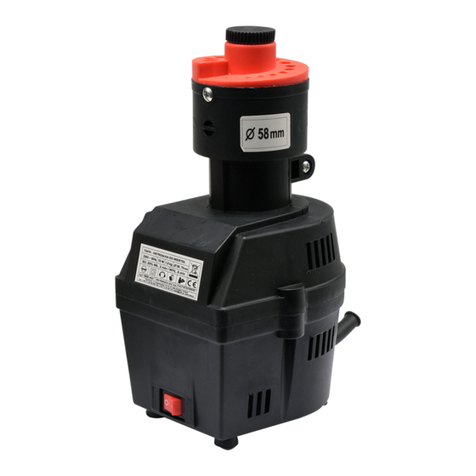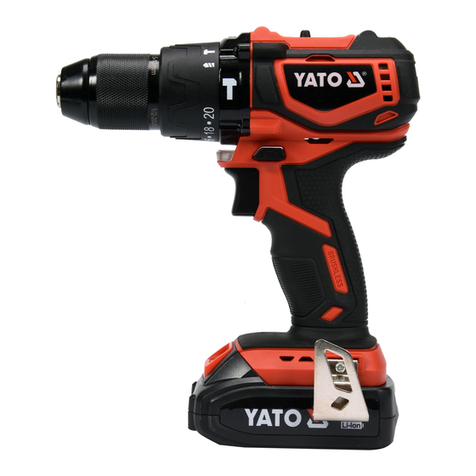YATO YT-828377 User manual

AKUMULATOROWY SEKATOR
CORDLESS PRUNING SHEARS
AKKU-ASTSCHERE
СЕКАТОР АККУМУЛЯТОРНЫЙ
СЕКАТОР АКУМУЛЯТОРНИЙ
AKUMULIATORINIS SEKATORIUS
AKUMULATORA DĀRZA GRIEZNES
AKUMULÁTOROVÉ ZAHRADNÍ NŮŽKY
AKUMULÁTOROVÉ ZÁHRADNÉ NOŽNICE
AKKUMULÁTOROS METSZŐOLLÓ
FOARFECE DE TĂIAT CU ACUMULATOR
TIJERAS DE PODA ELÉCTRICAS A BATERÍA
SÉCATEUR ÉLECTRIQUE SANS-FIL
CESOIA DA POTATURA A BATTERIA
ACCUSNOEISCHAAR
ΚΛΑΔΕΥΤΙΚΌ ΨΑΛΊΔΙ ΜΠΑΤΑΡΊΑΣ
АКУМУЛАТОРНА ГРАДИНСКА НОЖИЦА
PL
EN
DE
RU
UA
LT
LV
CZ
SK
HU
RO
ES
FR
IT
NL
GR
BG
YT-828377
INSTRUKCJA ORYGINALNA 1
YT-828378

INSTRUKCJA ORYGINALNA
2
PL EN DE RU UA LT LV CZ SK HU RO ES FR IT NL GR BG
TOYA S.A. ul. Sołtysowicka 13-15, 51-168 Wrocław, Polska
Rok produkcji:
Production year:
Produktionsjahr:
Год выпуска:
Рік випуску:
Pagaminimo metai:
Ražošanas gads:
Rok výroby:
Rok výroby:
2022 Gyártási év:
Anul producţiei utilajului:
Año de fabricación:
Année de fabrication:
Anno di produzione:
Bouwjaar:
Έτος παραγωγής:
I
VI
III
VII VIII
V
II
IV
1
2
3
5
7
6
5
4

INSTRUKCJA ORYGINALNA 3
PL EN DE RU UA LT LV CZ SK HU RO ES FR IT NL GR BG
1. rękojeść
2. gniazdo akumulatora
3. włącznik
4. dioda sygnalizacyjna
5. ostrze górne
6. ostrze dolne
7. akumulator
8. stacja ładująca
PL
1. handle
2. battery socket
3. power switch
4. LED lamp
5. upper blade
6. lower blade
7. battery
8. charging station
EN
1. Haltegri
2. Akkufach
3. Ein-/Aus-Taste
4. Kontrollleuchte
5. obere Klinge
6. untere Klinge
7. Akku
8. Ladestation
DE
1. рукоятка
2. гнездо аккумулятора
3. включатель
4. сигнальные диоды
5. верхнее лезвие
6. нижнее лезвие
7. аккумулятор
8. зарядная станция
RU
1. рукоятка
2. гніздо акумулятора
3. вимикач
4. сигнальний діод
5. верхнє лезо
6. нижнє лезо
7. акумулятор
8. зарядна станція
UA
1. laikiklis
2. akumuliatoriaus lizdas
3. jungiklis
4. signalizacijos diodas
5. viršutinis peilis
6. apatinis peilis
7. akumuliatorius
8. įkrovimo stotis
LT
1. rokturis
2. akumulatora ligzda
3. slēdzis
4. signalizācijas diode
5. augšējais asmens
6. apakšējais asmens
7. akumulators
8. uzlādes stacija
LV
1. rukojeť
2. zásuvka na baterie
3. vypínač
4. signalizační dioda
5. horní čepel
6. spodní čepel
7. baterie
8. nabíjecí stanice
CZ
1. mâner
2. lăcaș acumulator
3. comutator de alimentare
4. lampă LED
5. lamă superioară
6. lamă inferioară
7. acumulator
8. stație de încărcare a acumulatorului
RO
1. mango
2. toma de batería
3. interruptor de encendido
4. LED de señalización
5. cuchilla superior
6. cuchilla inferior
7. batería
8. estación de carga
ES
1. markolat
2. akkumulátor csatlakozóaljzat
3. bekapcsológomb
4. visszajelző lámpa
5. felső penge
6. alsó penge
7. akkumulátor
8. töltőállomás
HU
1. rukoväť
2. priehradka akumulátora
3. zapínač
4. signalizačná kontrolka
5. horná čepeľ
6. dolná čepeľ
7. akumulátor
8. nabíjacia stanica
SK
1. impugnatura
2. vano di alloggiamento della batteria
3. pulsante di accensione
4. diodo di segnalazione
5. lama superiore
6. lama inferiore
7. batteria
8. stazione di ricarica
IT
1. ръкохватка
2. гнездо за акумулатора
3. бутон за включване
4. сигнализационен диод
5. горно острие
6. долно острие
7. акумулатор
8. зарядна станция
BG
1. poignée
2. logement de la batterie
3. gâchette de l’interrupteur
4. voyant d’indication
5. lame supérieure
6. lame inférieure
7. batterie
8. station de chargement
FR
1. λαβή
2. υποδοχή μπαταρίας
3. διακόπτης λειτουργίας
4. ενδεικτική λυχνία
5. άνω λεπίδα
6. κάτω λεπίδα
7. μπαταρία
8. σταθμός φόρτισης
GR
1. handvat
2. accucontactdoos
3. schakelaar
4. signaleringsdiode
5. bovenste mes
6. onderste mes
7. accu
8. laadstation
NL
IX
8
7

INSTRUKCJA ORYGINALNA
4
PL EN DE RU UA LT LV CZ SK HU RO ES FR IT NL GR BG
Przeczytać instrukcję
Read the operating instruction
Bedienungsanleitung durchgelesen
Прочитать инструкцию
Прочитать iнструкцiю
Perskaityti instrukciją
Jālasa instrukciju
Přečtet návod k použití
Prečítať návod k obsluhe
Olvasni utasítást
Citeşti instrucţunile
Lea la instrucción
Lisez la notice d’utilisation
Leggere il manuale d’uso
Lees de instructies
Διαβάστε τις οδηγίες χρήσης
Прочетете ръководството
Używaj gogle ochronne
Wear protective goggles
Schutzbrille verwenden
Пользоваться защитными очками
Користуйтесь захисними окулярами
Vartok apsauginius akinius
Jālieto drošības brilles
Používej ochranné brýle
Používaj ochranné okuliare
Használjon védőszemüveget!
Intrebuinţează ochelari de protejare
Use protectores del oído
Portez des lunettes de protection
Utilizzare gli occhiali di protezione
Draag een veiligheidsbril
Χρησιμοποιήστε τα γυαλιά προστασίας
Използвайте защитни очила
Stosować rękawice ochronne
Use protective gloves
Schutzhandschuhe verwenden
Необходимо пользоваться защитными перчатками
Слід користуватися захисними рукавицями
Vartoti apsaugines pirštines
Lietot aizsardzības cimdus
Používejte ochranné rukavice
Používajte ochranné rukavice
Használjon védőkesztyűt
Utilizarea mănuşilor de protrcţie
Use guantes de protección
Portez des gants de protection
Utilizzare i guanti di protezione
Gebruik beschermende handschoenen
Φορέστε τα γάντια προστασίας
Използвайте защитни ръкавици
Stosuj kask ochronny
Use a protective helmet
Verwenden Sie einen Schutzhelm
Используйте защитный шлем
Використовуйте захисний шолом
Naudokite apsauginį šalmą
Izmantojiet aizsargķiveri
Používejte ochrannou přilbu
Používajte ochrannú prilbu
Használjon védősisakot
Folosiți o cască de protecție
Usa un casco protector
Utiliser un casque de protection
Usa un casco protettivo
Gebruik een beschermende helm
Χρησιμοποιήστε προστατευτικό κράνος
Използвайте защитна каска
Nie wystawiać na działanie opadów atmosferycznych
Do not expose to precipitation
Nicht dem Niederschlag aussetzen
Не подвергать влиянию атмосферных осадков
Не піддавати дії атмосферних опадів
Nestatyti pjūklo į atmosferinių kritulių poveikio pavojų
Nedrīkst atstāt zem atmosfēriskiem nokrišņiem
Nevystavovat působení atmosférických srážek
Nevystavovať pôsobeniu atmosférických zrážok
Soha ne tegye ki csapadék hatásának
Eviataţi expunerea ferăstrăului la precipitaţiile atmosferice
No exponga la herramienta a la humedad
Ne pas exposer aux précipitations
Non esporre a precipitazioni
Niet blootstellen aan neerslag
Μην εκθέτετε τις βροχοπτώσεις
Не излагайте на валежи
Trzymać ręce z dala od ostrzy
Keep your hands away from the blades
Hände von Klingen fernhalten
Держите руки подальше от лезвий
Тримати руки подалі від лез
Laikykite rankas toliau nuo peilių.
Turiet rokas tālāk no asmeņiem
Udržujte ruce mimo dosah nožů
Ruky držte dostatočne ďaleko od čepelí
Tartsa távol kezét a pengéktől
Țineți mâinile la distanță de lame
Mantenga las manos alejadas de las cuchillas
Garder les mains éloignées des lames
Tenere le mani lontano dalle lame
Houd uw handen uit de buurt van de messen
Κρατήστε τα χέρια μακριά από τις λεπίδες
Дръжте ръцете си далеч от остриетата
Oświetlenie – nie wpatrywać się w źródło światła
Lighting – do not stare at the light source
Beleuchtung – Nicht in die Lichtquelle blicken
Освещение – не смотрите на источник света
Освітлення – не дивіться на джерело світла
Apšvietimas – nežiūrėkite į šviesos šaltinį
Apgaismojums – neskatieties uz gaismas avotu
Osvětlení – nedívejte se do zdroje světla
Osvetlenie – nepozerajte sa priamo do svetelného zdroja
Világítás – ne nézzen a fényforrásba
Iluminare – nu priviți continuu spre sursa de lumină
Iluminación: no mire jamente a la fuente de luz
Éclairage – ne pas regarder la source lumineuse
Illuminazione – non guardare direttamente la fonte di luce
Verlichting – niet naar de lichtbron staren
Φωτισμός – μην κοιτάζετε επίμονα την πηγή φωτός
Осветление – не се взирайте в светлинния източник

INSTRUKCJA ORYGINALNA 5
PL EN DE RU UA LT LV CZ SK HU RO ES FR IT NL GR BG
Ten symbol informuje o zakazie umieszczania zużytego sprzętu elektrycznego i elektronicznego (w tym baterii i akumulatorów) łącznie z innymi odpadami. Zużyty sprzęt
powinien być zbierany selektywnie i przekazany do punktu zbierania w celu zapewnienia jego recyklingu i odzysku, aby ograniczać ilość odpadów oraz zmniejszyć stopnień
wykorzystania zasobów naturalnych. Niekontrolowane uwalnianie składników niebezpiecznych zawartych w sprzęcie elektrycznym i elektronicznym może stanowić zagroże-
nie dla zdrowia ludzkiego oraz powodować negatywne zmiany w środowisku naturalnym. Gospodarstwo domowe pełni ważną rolę w przyczynianiu się do ponownego użycia
i odzysku, w tym recyklingu zużytego sprzętu. Więcej informacji o właściwych metodach recyklingu można uzyskać u władz lokalnych lub sprzedawcy.
Dieses Symbol weist darauf hin, dass Elektro- und Elektronik-Altgeräte (einschließlich Batterien und Akkumulatoren) nicht zusammen mit anderen Abfällen entsorgt werden
dürfen. Altgeräte sollten getrennt gesammelt und bei einer Sammelstelle abgegeben werden, um deren Recycling und Verwertung zu gewährleisten und so die Abfallmenge
und die Nutzung natürlicher Ressourcen zu reduzieren. Die unkontrollierte Freisetzung gefährlicher Stoe, die in Elektro- und Elektronikgeräten enthalten sind, kann eine
Gefahr für die menschliche Gesundheit darstellen und negative Auswirkungen auf die Umwelt haben. Der Haushalt spielt eine wichtige Rolle bei der Wiederverwendung
und Verwertung, einschließlich des Recyclings von Altgeräten. Weitere Informationen zu den geeigneten Recyclingverfahren erhalten Sie bei den örtlichen Behörden oder
Ihrem Händler.
Этот символ информирует о запрете помещать изношенное электрическое и электронное оборудование (в том числе батареи и аккумуляторы) вместе с другими
отходами. Изношенное оборудование должно собираться селективно и передаваться в точку сбора, чтобы обеспечить его переработку и утилизацию, для
того, чтобы ограничить количество отходов, и уменьшить использование природных ресурсов. Неконтролируемый выброс опасных веществ, содержащихся в
электрическом и электронном оборудовании, может представлять угрозу для здоровья человека, и приводить к негативным изменениям в окружающей среде.
Домашнее хозяйство играет важную роль при повторном использовании и утилизации, в том числе, утилизации изношенного оборудования. Подробную
информацию о правильных методах утилизации можно получить у местных властей или у продавца.
This symbol indicates that waste electrical and electronic equipment (including batteries and storage cells) cannot be disposed of with other types of waste. Waste equipment
should be collected and handed over separately to a collection point for recycling and recovery, in order to reduce the amount of waste and the use of natural resources. Un-
controlled release of hazardous components contained in electrical and electronic equipment may pose a risk to human health and have adverse eects for the environment.
The household plays an important role in contributing to reuse and recovery, including recycling of waste equipment. For more information about the appropriate recycling
methods, contact your local authority or retailer.
Цей символ повідомляє про заборону розміщення відходів електричного та електронного обладнання (в тому числі акумуляторів), у тому числі з іншими
відходами. Відпрацьоване обладнання повинно бути вибірково зібрано і передано в пункт збору для забезпечення його переробки і відновлення, щоб зменшити
кількість відходів і зменшити ступінь використання природних ресурсів. Неконтрольоване вивільнення небезпечних компонентів, що містяться в електричному та
електронному обладнанні, може представляти небезпеку для здоров’я людини і викликати негативні зміни в навколишньому середовищі. Господарство відіграє
важливу роль у розвитку повторного використання та відновлення, включаючи утилізацію використаного обладнання. Більш детальну інформацію про правильні
методи утилізації можна отримати у місцевої влади або продавця.
Ostrzeżenie!
Warning!
Warnung!
Внимание!
Увага!
Įspėjimas!
Brīdinājums!
Upozornění!
Varovanie!
Figyelmeztetés!
Avertizare!
¡Advertencia!
Attention!
Avvertenza!
Waarschuwing!
Προειδοποίηση!
Внимание!
Strzec się wyrzucanych przedmiotów
Beware of the discarded items
Vor den ausgeworfenen Gegenständen sollte man sich schützen
Не забывать о возможности выброса предметов
Памятайте про можливість викиду предметів
Saugotis iš po dalgio išmetamų daiktų
Piesargāties no izmestiem priekšmetiem
Chraňte se před odmršťovanými předměty
Chráňte sa pred vymršťovanými predmetmi
Óvakodjon a kirepülő tárgyaktól
Feriţi-vă de elementele aruncate de coasă
Evite los objetos que pueden ser expulsados por la podadora
Attention aux objets éjectés
Far attenzione agli oggetti proiettati
Wees voorzichtig met weggegooide voorwerpen
Μείνετε μακριά από τα εκτοξευόμενα αντικείμενα
Пазете се от хвърлени предмети
Pozostawać z dala od osób postronnych
Stay away from bystanders
Die unbefugten Personen fern halten
Хранить вдали от посторонних лиц
Перебувати здаля від посторонніх осіб
Dirbti saugiame atstume nuo pašalinių asmenų
Atstāties tālu no nepiederošām personām
Dodržovat bezpečnou vzdálenost od druhých osob
Dodržiavať bezpečnú vzdialenosť od ostatných osôb
Az illetéktelen személyektől távol tárolja
Menţine distanţă faţă de persoane lăturalnice
Manténgase lejos de los terceros
Restez à l’écart des passants
Stai lontano dagli astanti
Blijf uit de buurt van omstanders
Μείνετε μακριά από τους παρευρισκόμενους
Стойте далеч от странични хора
This manual suits for next models
1
Table of contents
Languages:
Other YATO Power Tools manuals
